Äîêóìåíòàöèÿ è îïèñàíèÿ www.docs.chipfind.ru
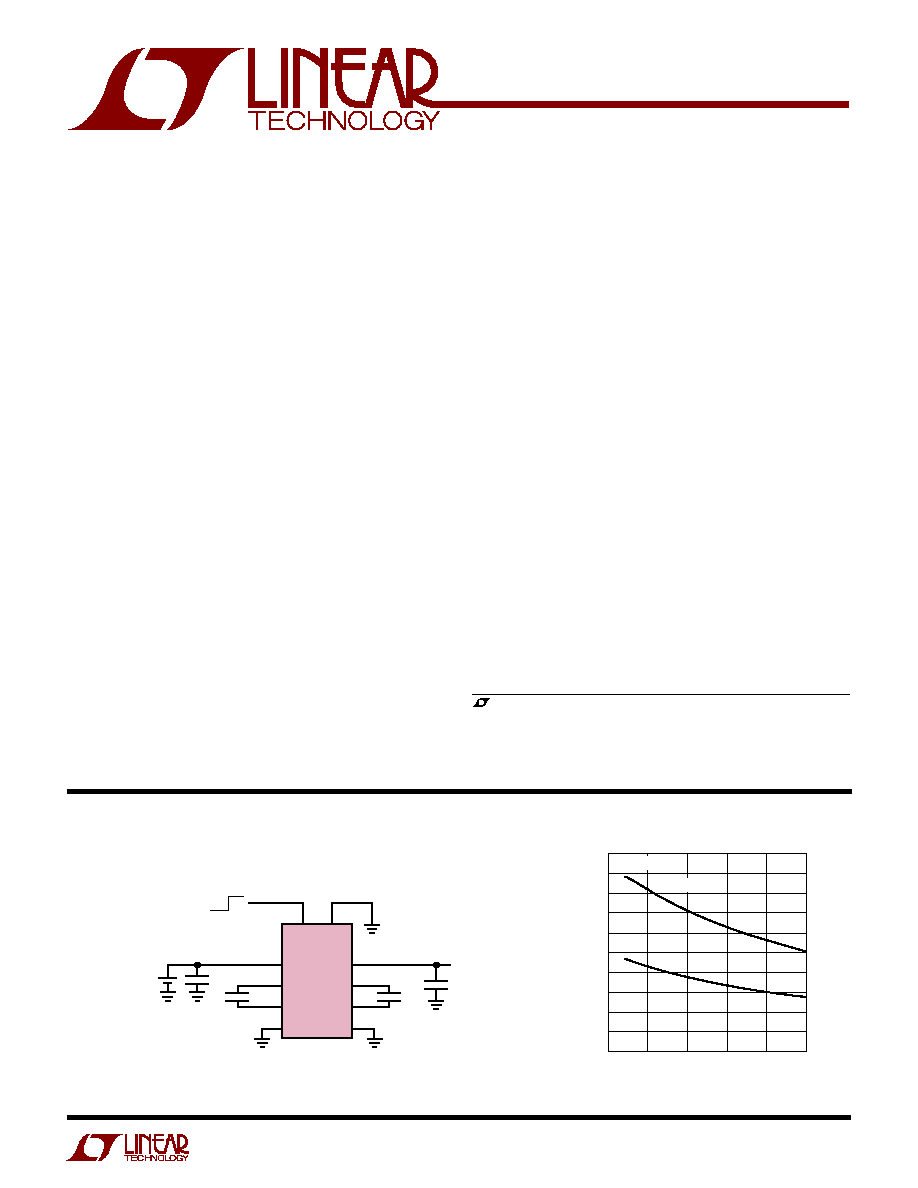
1
LTC3251/
LTC3251-1.2/LTC3251-1.5
32511215fa
Burst Mode is a registered trademark of Linear Technology Coareoration.
Super Burst is a trademark of Linear Technology Corporation.
*U.S. Patent #6, 411, 531
APPLICATIO S
U
FEATURES
DESCRIPTIO
U
TYPICAL APPLICATIO
U
500mA High Efficiency,
Low Noise, Inductorless
Step-Down DC/DC Converter
Spread Spectrum Step-Down Converter
, LTC and LT are registered trademarks of Linear Technology Corporation.
1.5V Efficiency vs Input Voltage
(Burst Mode Operation)
The LTC
®
3251/LTC3251-1.2/LTC3251-1.5 are 2-phase
charge pump step-down DC/DC converters that produce a
regulated output from a 2.7V to 5.5V input. The parts use
switched capacitor fractional conversion to achieve twice
the typical efficiency of a linear regulator. No inductors are
required. V
OUT
is resistor programmable from 0.9V to 1.6V
or fixed at 1.2V or 1.5V, with up to 500mA of load current
available.
A unique 2-phase spread spectrum architecture provides
a very low noise regulated output as well as low noise at the
input.* The parts have four operating modes: Continuous
Spread Spectrum, Spread Spectrum with Burst Mode
operation, Super Burst
TM
mode operation and shutdown.
Low operating current (35
µ
A in Burst Mode operation,
10
µ
A in Super Burst mode operation) and low external
parts count make the LTC3251/LTC3251-1.2/LTC3251-1.5
ideally suited for space-constrained battery-powered
applications. The parts are short-circuit and overtempera-
ture protected, and are available in a thermally enhanced
10-pin MSOP package.
s
Up to 500mA Output Current
s
No Inductors
s
2.7V to 5.5V Input Voltage Range
s
2x Efficiency Improvement Over LDOs
s
2-Phase, Spread Spectrum Operation
for Low Input and Output Noise
s
Shutdown Disconnects Load from V
IN
s
Adjustable Output Voltage Range: 0.9V to 1.6V
Fixed Output Voltages: 1.2V, 1.5V
s
Super Burst, Burst and Burst Defeat Operating Modes
s
Low Operating Current: I
IN
= 35
µ
A (Burst Mode
®
Operation)
s
Super Burst Operating Current: I
IN
= 10
µ
A
s
Low Shutdown Current: I
IN
= 0.01
µ
A Typ
s
Soft-Start Limits Inrush Current at Turn-On
s
Short-Circuit and Overtemperature Protected
s
Available in a Thermally Enhanced
10-Pin MSOP Package
s
Handheld Devices
s
Cellular Phones
s
Portable Electronic Equipment
s
DSP Power Supplies
MD0 MD1
LTC3251-1.5
V
IN
C1
+
1
µ
F
1
µ
F
1-CELL Li-Ion
OR
3-CELL NiMH
OFF ON
C1
GND
V
OUT
C2
+
C2
MODE
1
µ
F
10
µ
F
V
OUT
= 1.5V
500mA
3251 TA01
1
9
2
3
4
5, 11
7
8
6
10
INPUT VOLTAGE (V)
3
EFFICIENCY (%)
60
80
100
5
3251 TA02
40
20
50
70
90
30
10
0
3.5
4
4.5
5.5
LTC3251-1.5
LDO
I
OUT
= 200mA
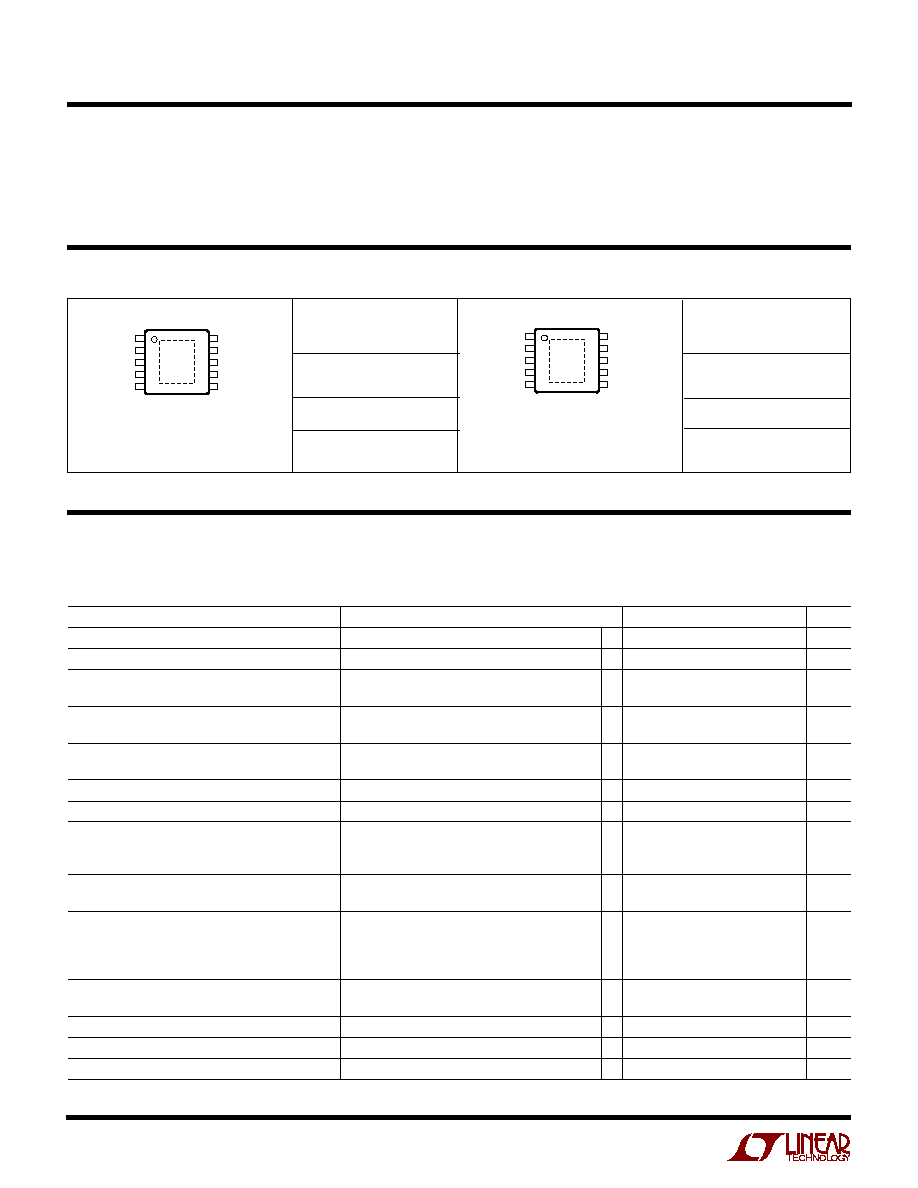
2
LTC3251/
LTC3251-1.2/LTC3251-1.5
32511215fa
ABSOLUTE AXI U RATI GS
W
W
W
U
PACKAGE/ORDER I FOR ATIO
U
U
W
Consult LTC Marketing for parts specified with wider operating temperature ranges.
ELECTRICAL CHARACTERISTICS
PARAMETER
CONDITIONS
MIN
TYP
MAX
UNITS
V
IN
Minimum Operating Voltage
(Notes 4,5)
q
2.7
V
V
IN
Maximum Operating Voltage
(Note 5)
q
5.5
V
V
IN
Continuous Mode Operating Current
I
OUT
= 0mA, V
MD0
= 0, V
MD1
= V
IN
q
3
5
mA
Spread Spectrum Disabled MODE = V
IN
q
3.75
6
mA
V
IN
Burst Mode Operating Current
I
OUT
= 0mA, V
MD0
= V
IN
, V
MD1
= 0
q
35
60
µ
A
Spread Spectrum Disabled MODE = V
IN
q
35
60
µ
A
V
IN
Super Burst Mode Operating Current
I
OUT
= 0mA, V
MD0
= V
IN
, V
MD1
= V
IN
q
10
15
µ
A
Spread Spectrum Disabled MODE = V
IN
q
10
15
µ
A
V
IN
Shutdown Current
V
MD0
= 0V, V
MD1
= 0V (Note 5)
q
0.01
1
µ
A
V
FB
Regulation Voltage (LTC3251)
I
OUT
= 0mA, 2.7V
V
IN
5.5V
q
0.78
0.8
0.82
V
V
OUT
Regulation Voltage (LTC3251-1.2)
I
OUT
200mA, 2.7V
V
IN
5.5V (Note 5)
q
1.15
1.2
1.25
V
Continuous Mode or Burst Mode Operation
I
OUT
300mA, 2.8V
V
IN
5.5V (Note 5)
q
1.15
1.2
1.25
V
I
OUT
500mA, 3V
V
IN
5.5V (Note 5)
1.15
1.2
1.25
V
V
OUT
Regulation Voltage (LTC3251-1.2)
I
OUT
40mA
q
1.15
1.2
1.25
V
Super Burst Operation
V
OUT
Regulation Voltage (LTC3251-1.5)
I
OUT
100mA, 3.1V
V
IN
5.5V (Note 5)
q
1.44
1.5
1.56
V
Continuous Mode or Burst Mode Operation
I
OUT
200mA, 3.2V
V
IN
5.5V (Note 5)
q
1.44
1.5
1.56
V
I
OUT
300mA, 3.3V
V
IN
5.5V (Note 5)
q
1.44
1.5
1.56
V
I
OUT
500mA, 3.5V
V
IN
5.5V (Note 5)
1.44
1.5
1.56
V
V
OUT
Regulation Voltage (LTC3251-1.5)
I
OUT
40mA
q
1.44
1.5
1.56
V
Super Burst Operation
I
OUT
Continuous Output Current (LTC3251)
V
MD0
= 0, V
MD1
= V
IN
or V
MD0
= V
IN
, V
MD1
= 0
q
500
mA
I
OUT
Super Burst Output Current (LTC3251)
V
MD0
= V
IN
, V
MD1
= V
IN
q
40
mA
Load Regulation (LTC3251)
0mA
I
OUT
500mA, Referred to FB Pin
0.045
mV/mA
ORDER PART
NUMBER
MSE PART MARKING
EXPOSED PAD IS GND (PIN 11),
MUST BE SOLDERED TO PCB
T
JMAX
= 125
°
C,
JA
= 40
°
C/W,
JC
= 10
°
C/W
(Notes 1, 7)
V
IN
to GND ................................................... 0.3V to 6V
MD0, MD1, MODE and FB to GND . 0.3V to (V
IN
+ 0.3V)
I
OUT
(Note 2) ...................................................... 650mA
LTC3251EMSE
The
q
denotes the specifications which apply over the full operating
temperature range, otherwise specifications are at T
A
= 25
°
C. V
IN
= 3.6V, C1 = C2 = 1
µ
F, C
IN
= 1
µ
F, C
OUT
= 10
µ
F,
V
MODE
= 0V for LTC3251-1.2V or LTC3251-1.5, V
OUT
= 1.5V for LTC3251, all capacitors ceramic, unless otherwise noted.
LTB4
Operating Temperature Range (Note 3) ... 40
°
C to 85
°
C
Storage Temperature Range .................. 65
°
C to 150
°
C
Lead Temperature (Soldering, 10 sec)................... 300
°
C
ORDER PART
NUMBER
MSE PART MARKING
EXPOSED PAD IS GND (PIN 11),
MUST BE SOLDERED TO PCB
T
JMAX
= 125
°
C,
JA
= 40
°
C/W,
JC
= 10
°
C/W
LTC3251EMSE-1.2
LTC3251EMSE-1.5
LTAGM
LTABE
1
2
3
4
5
MD0
V
IN
C1
+
C1
GND
10
9
8
7
6
FB
MD1
C2
+
V
OUT
C2
TOP VIEW
MSE PACKAGE
10-LEAD PLASTIC MSOP
11
1
2
3
4
5
MD0
V
IN
C1
+
C1
GND
10
9
8
7
6
MODE
MD1
C2
+
V
OUT
C2
TOP VIEW
MSE PACKAGE
10-LEAD PLASTIC MSOP
11
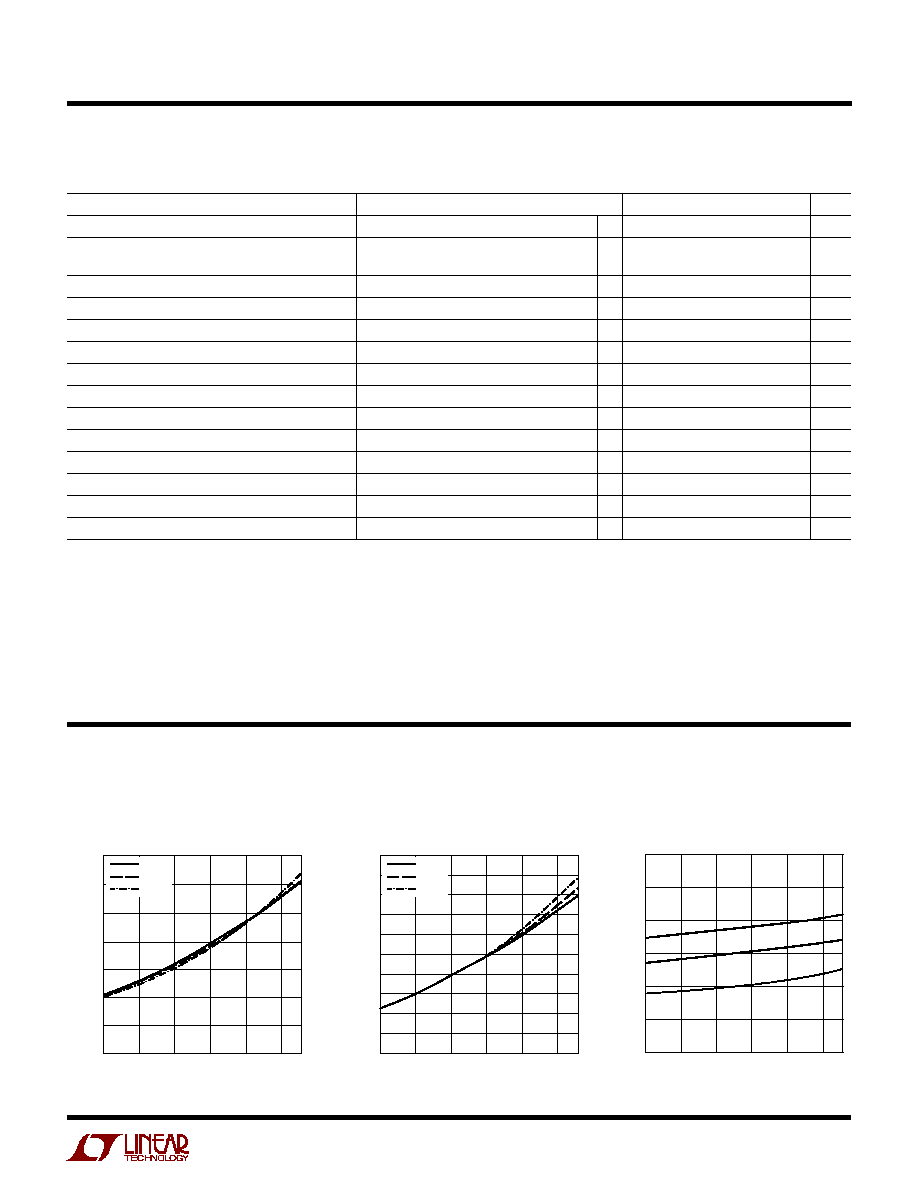
3
LTC3251/
LTC3251-1.2/LTC3251-1.5
32511215fa
TYPICAL PERFOR A CE CHARACTERISTICS
U
W
No Load Supply Current vs Supply
Voltage (Continuous Mode Spread
Spectrum Enabled)
No Load Supply Current vs Supply
Voltage (Burst Mode Operation)
V
IN
(V)
2.7
7
6
5
4
3
2
1
0
4.2
5.2
3251 G01
3.2
3.7
4.7
I
IN
(mA)
40
°
C
25
°
C
85
°
C
V
IN
(V)
2.7
50
45
40
85
°
C
25
°
C
40
°
C
35
30
25
20
4.2
5.2
3251 G02
3.2
3.7
4.7
I
IN
(
µ
A)
PARAMETER
CONDITIONS
MIN
TYP
MAX
UNITS
Line Regulation (LTC3251)
I
OUT
= 500mA, 2.7V
V
IN
5.5V
0.2
%/V
Spread Spectrum Frequency Range
f
MIN
Switching Frequency
q
0.7
1.0
MHz
f
MAX
Switching Frequency
q
1.6
2
MHZ
Spread Spectrum Disabled Frequency
MODE = V
IN
q
1.3
1.6
2
MHz
MD0, MD1 Input High Voltage
2.7V
V
IN
5.5V
q
0.8
1.2
V
MD0, MD1 Input Low Voltage
2.7V
V
IN
5.5V
q
0.4
0.8
V
MD0, MD1 Input High Current
MD0 = V
IN
, MD1 = V
IN
q
1
1
µ
A
MD0, MD1 Input Low Current
MD0 = 0V, MD1 = 0V
q
1
1
µ
A
FB Input Current (LTC3251)
V
FB
= 0.85V
q
50
50
nA
MODE Input High Voltage (LTC3251-1.2/LTC3251-1.5)
2.7V
V
IN
5.5V
q
50
70
%/V
IN
MODE Input Low Voltage (LTC3251-1.2/LTC3251-1.5)
2.7V
V
IN
5.5V
q
30
50
%/V
IN
MODE Input High Current (LTC3251-1.2/LTC3251-1.5)
MODE = V
IN
q
1
1
µ
A
MODE Input Low Current (LTC3251-1.2/LTC3251-1.5)
MODE = 0V
q
1
1
µ
A
Turn-On Time (Burst or Continuous Mode Operation)
R
OL
= 3
, (Note 5)
1
ms
Open-Loop Output Impedance (LTC3251)
V
IN
= 3V, I
OUT
= 200mA (Note 6)
q
0.45
0.7
Note 1: Absolute Maximum Ratings are those values beyond which the life
of a device may be impaired.
Note 2: Based on long term current density limitations.
Note 3: The LTC3251E is guaranteed to meet specified performance from
0
°
C to 70
°
C. Specifications over the 40
°
C to 85
°
C operating temperature
range are assured by design, characterization and correlation with
statistical process controls.
Note 4: Minimum operating voltage required for regulation is:
V
IN
2 · (V
OUT
+ R
OL
· I
OUT
)
Note 5: V
MODE
= 0V or V
MODE
= V
IN
for LTC3251-1.2/LTC3251-1.5.
Note 6: Output not in regulation; R
OL
= (V
IN
/2 V
OUT
)/I
OUT
.
(V
FB
= 0.76V). Burst or continuous mode operation.
Note 7: This IC includes overtemperature protection that is intended to
protect the device during momentary overload conditions. Junction
temperature will exceed 125
°
C when overtemperature protection is active.
Continuous operation above the specified maximum operating junction
temperature may impair device reliability.
The
q
denotes the specifications which apply over the full operating
temperature range, otherwise specifications are at T
A
= 25
°
C. V
IN
= 3.6V, C1 = C2 = 1
µ
F, C
IN
= 1
µ
F, C
OUT
= 10
µ
F,
V
MODE
= 0V for LTC3251-1.2V or LTC3251-1.5, V
OUT
= 1.5V for LTC3251, all capacitors ceramic, unless otherwise noted.
ELECTRICAL CHARACTERISTICS
No Load Supply Current vs Supply
Voltage (Continuous Mode,
Spread Spectrum Disabled)
V
IN
(V)
2.7
10
9
8
7
6
5
4
3
2
1
0
4.2
5.2
3251 G17
3.2
3.7
4.7
I
CC
(mA)
40
°
C
25
°
C
85
°
C

4
LTC3251/
LTC3251-1.2/LTC3251-1.5
32511215fa
1.5V Output Voltage vs Supply
Voltage (Burst Mode Operation/
Continuous Mode)
V
IN
(V)
3
V
OUT
(V)
1.52
1.56
1.60
5
3251 G04
1.48
1.44
1.50
1.54
1.58
1.46
1.42
1.40
3.5
4
4.5
5.5
I
OUT
= 0mA
I
OUT
= 250mA
I
OUT
= 500mA
T
A
= 25
°
C
1.2V Output Voltage vs Supply
Voltage (Burst Mode Operation/
Continuous Mode)
V
IN
(V)
2.7
1.300
1.260
1.220
1.180
1.140
1.280
1.240
1.200
1.160
1.120
1.100
4.2
5.2
3251 G05
3.2
3.7
4.7
V
OUT
(V)
I
OUT
= 0mA
I
OUT
= 500mA
I
OUT
= 250mA
T
A
= 25
°
C
1.5V Output Voltage
vs Supply Voltage
(Super Burst Mode Operation)
V
IN
(V)
3
V
OUT
(V)
1.52
1.56
1.60
5
3251 G06
1.48
1.44
1.50
1.54
1.58
1.46
1.42
1.40
3.5
4
4.5
5.5
T
A
= 25
°
C
0mA
10mA
40mA
FB Voltage vs Output Current
(Burst Mode Operation/
Continuous Mode)
1.5V Output Efficiency vs Output
Current (Burst Mode Operation)
I
OUT
(mA)
0
0.780
V
FB
(V)
0.785
0.790
0.795
0.800
0.805
100
200
300
400
3251 G07
500
600
T
A
= 25
°
C
V
OUT
= 1.5V
I
OUT
(mA)
0.1
0
EFFICIENCY (%)
10
30
40
50
100
70
1
10
3251 G08
20
80
90
60
100
1000
V
IN
= 3.3V
MD0 = V
IN
, MD1 = 0V
V
IN
= 4V
V
IN
= 5V
V
IN
= 3.6V
1.5V Output Efficiency vs Output
Current (Super Burst Mode
Operation)
I
OUT
(mA)
0.1
0
EFFICIENCY (%)
10
30
40
50
100
70
1
10
3251 G09
20
80
90
60
100
V
IN
= 3.3V
V
IN
= 4V
V
IN
= 5V
V
IN
= 3.6V
MD0 = MD1 = V
IN
TYPICAL PERFOR A CE CHARACTERISTICS
U
W
No Load Supply Current
vs Supply Voltage
(Super Burst Mode Operation)
V
IN
(V)
2.7
20
16
12
8
4
18
14
10
6
2
0
4.2
5.2
3251 G02
3.2
3.7
4.7
I
CC
(
µ
A)
85
°
C
25
°
C
40
°
C
1.2V Output Voltage
vs Supply Voltage
(Super Burst Mode Operation)
1.2V Output Efficiency vs Output
Current (Burst Mode Operation)
V
IN
(V)
2.7
1.30
1.28
1.26
1.24
1.22
1.20
1.18
1.16
1.14
1.12
1.10
4.2
5.2
3251 G18
3.2
3.7
4.7
V
OUT
(V)
0mA
10mA
40mA
T
A
= 25
°
C
I
OUT
(mA)
0.1
100
80
60
40
20
90
70
50
30
10
0
10
1000
3251 G19
1
100
EFFICIENCY (%)
V
IN
= 2.7V
V
IN
= 3.5V
V
IN
= 4.5V
V
IN
= 3V
MD0 = V
IN
, MD1 = 0V
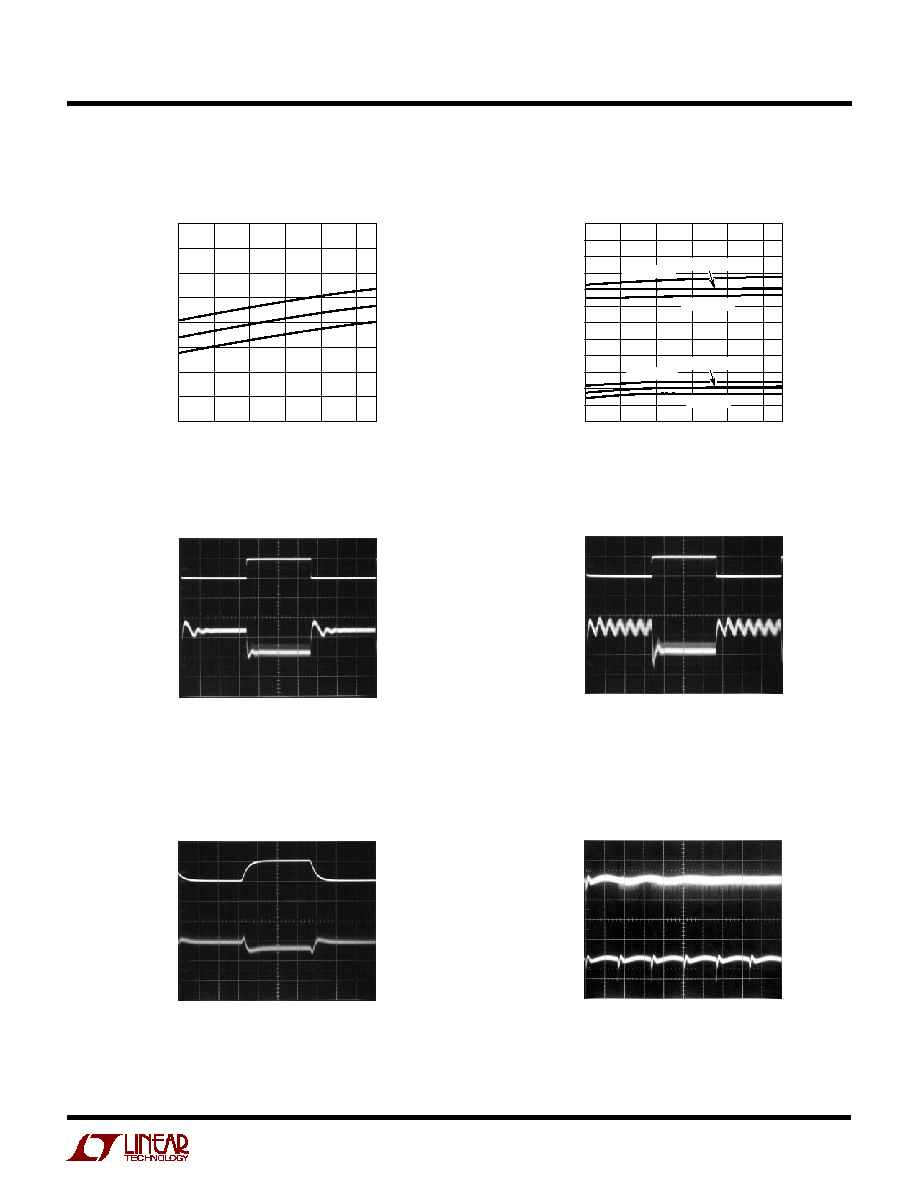
5
LTC3251/
LTC3251-1.2/LTC3251-1.5
32511215fa
TYPICAL PERFOR A CE CHARACTERISTICS
U
W
MD0/MD1 Input Threshold Voltage
vs Supply Voltage
Max/Min Oscillator Frequency
vs Supply Voltage
V
IN
(V)
2.7
1.2
1.0
0.8
85
°
C
40
°
C
0.6
1.1
0.9
0.7
0.5
0.4
4.2
5.2
3251 G10
3.2
3.7
4.7
MD0/MD1 THRESHOLD (V)
25
°
C
V
IN
(V)
2.7
0.8
FREQUENCY (MHz)
1.0
1.2
1.4
1.6
2.0
3.2
3.7
4.2
4.7
3251 G11
5.2
1.8
0.9
1.1
1.3
1.5
1.9
1.7
40
°
C MAX
40
°
C MIN
25
°
C MAX
25
°
C MIN
85
°
C MAX
85
°
C MIN
Output Transient Response
(Continuous Mode)
450mA
50mA
I
OUT
V
OUT
20mV/DIV
(AC)
T
A
= 25
°
C
10
µ
s/DIV
3251 G13
C
OUT
= 10
µ
F X5R 6.3V
V
OUT
= 1.5V
Output Transient Response
(Burst Mode Operation)
450mA
50mA
I
OUT
V
OUT
20mV/DIV
(AC)
T
A
= 25
°
C
10
µ
s/DIV
3251 G14
C
OUT
= 10
µ
F X5R 6.3V
V
OUT
= 1.5V
Supply Transient Response
(Continuous Mode)
4.5V
3.5V
V
IN
V
OUT
20mV/DIV
(AC)
T
A
= 25
°
C
20
µ
s/DIV
3251 G15
C
OUT
= 10
µ
F X5R 6.3V
I
OUT
= 250mA
V
OUT
= 1.5V
LTC3251-1.5 Output Voltage
Ripple
SPREAD
SPECT
DISABLED
10mV/DIV (AC)
SPREAD
SPECT
ENABLED
10mV/DIV (AC)
T
A
= 25
°
C
200ns/DIV
3251 G16
C
OUT
= 10
µ
F X5R 6.3V
I
OUT
= 500mA
V
OUT
= 1.5V
V
OUT
20mV/DIV (AC)
V
IN
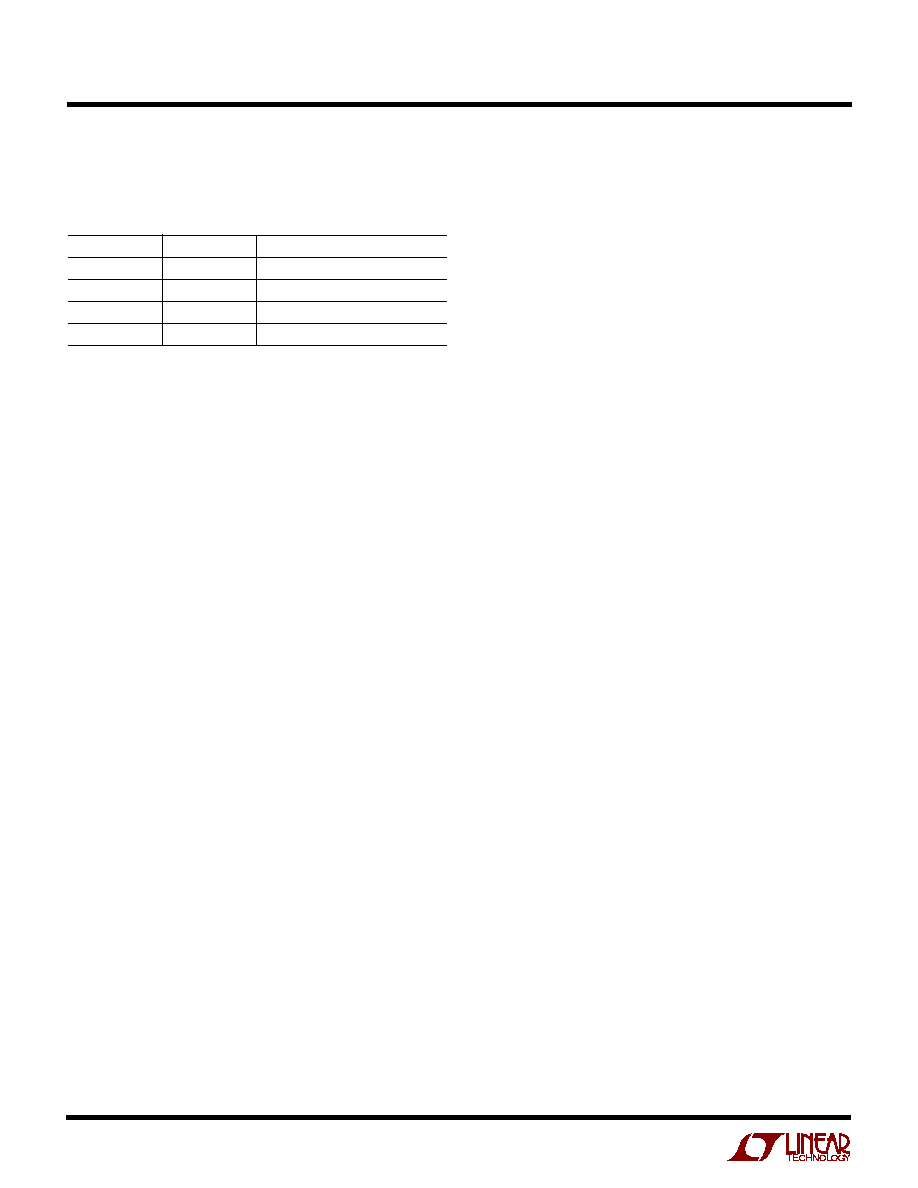
6
LTC3251/
LTC3251-1.2/LTC3251-1.5
32511215fa
U
U
U
PI FU CTIO S
MD0 (Pin 1)/MD1 (Pin 9): Switching Mode Input Pins. The
Mode input pins are used to set the operating mode of the
LTC3251. The modes of operation are:
MD1
MD0
OPERATING MODE
0
0
Shutdown
0
1
Spread Spectrum with Burst
1
0
Continuous Spread Spectrum
1
1
Super Burst
MD0 and MD1 are high impedance CMOS inputs and must
not be allowed to float.
V
IN
(Pin 2): Input Supply Voltage. Operating V
IN
may be
between 2.7V and 5.5V. Bypass V
IN
with a
1
µ
F low ESR
ceramic capacitor to GND (C
OUT
).
C1
+
(Pin 3): Flying Capacitor 1 Positive Terminal (C1).
C1
(Pin 4): Flying Capacitor 1 Negative Terminal (C1).
GND (Pin 5, 11): Ground. Connect to a ground plane for
best performance.
C2
(Pin 6): Flying Capacitor 2 Negative Terminal (C2).
V
OUT
(Pin 7): Regulated Output Voltage. V
OUT
is discon-
nected from V
IN
during shutdown. Bypass V
OUT
with a
low ESR ceramic capacitor to GND (C
IN
). See V
OUT
Capacitor Selection for capacitor size requirements.
C2
+
(Pin 8): Flying Capacitor 2 Positive Terminal (C2).
FB (Pin 10) (LTC3251): Feedback Input Pin. An output
divider should be connected from V
OUT
to FB to program
the output voltage.
MODE (Pin 10) (LTC3251-1.2/LTC3251-1.5): Spread
Spectrum Operation Mode Pin. A low voltage on MODE
enables spread spectrum operation. When MODE is high
spread spectrum operation is disabled and switching
occurs at the maximum operating frequency.
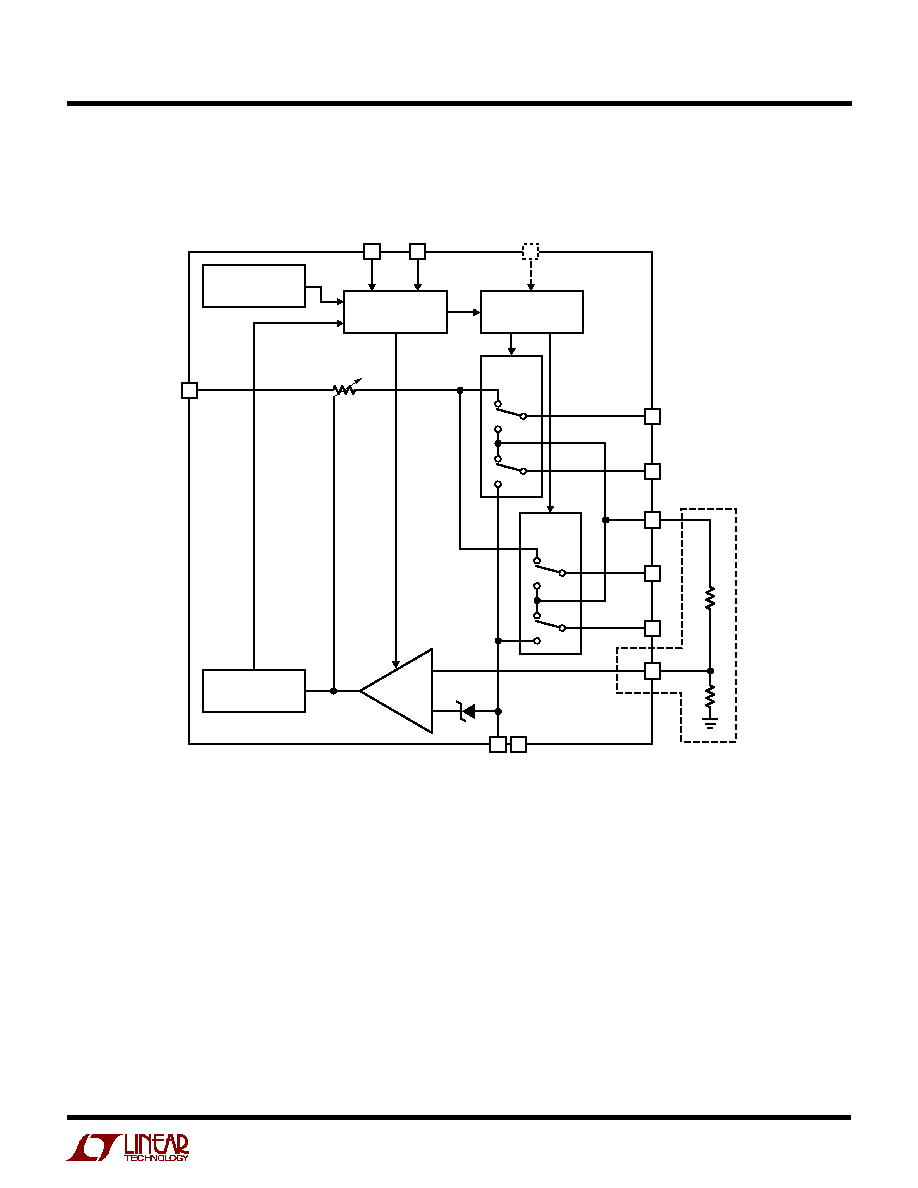
7
LTC3251/
LTC3251-1.2/LTC3251-1.5
32511215fa
SI PLIFIED
W
BLOCK DIAGRA
W
3
2
1
9
4
CHARGE
PUMP 1
SPREAD SPECTRUM
OSCILLATOR
C1
+
C1
C2
+
C2
7
V
OUT
10
5
11
FB
MODE
CHARGE
PUMP 2
8
6
SWITCH CONTROL
AND SOFT-START
V
IN
MD0
MD1
GND
3251 BD
+
BURST DETECT
CIRCUIT
INTERNAL ON
LTC3251-1.2/
LTC3251-1.5
10
LTC3251-1.2/
LTC3251-1.5
ONLY
OVERTEMP

8
LTC3251/
LTC3251-1.2/LTC3251-1.5
32511215fa
OPERATIO
U
(Refer to Block Diagram)
The LTC3251 family of parts use a dual phase switched
capacitor charge pump to step down V
IN
to a regulated
output voltage. Regulation is achieved by sensing the
output voltage through an external resistor divider and
modulating the charge pump output current based on the
error signal. A 2-phase nonoverlapping clock activates the
two charge pumps. The two charge pumps work in paral-
lel, but out of phase from each other. On the first phase of
the clock, current is transferred from V
IN
, through the
external flying capacitor 1, to V
OUT
via the switches of
Charge Pump 1. Not only is current being delivered to V
OUT
on the first phase, but the flying capacitor is also being
charged. On the second phase of the clock, flying capaci-
tor 1 is connected from V
OUT
to ground, transferring the
charge stored during the first phase of the clock to V
OUT
via
the switches of Charge Pump 1. Charge Pump 2 operates
in the same manner, but with the phases of the clock
reversed. This dual phase architecture achieves extremely
low output and input noise by providing constant charge
transfer from V
IN
to V
OUT
.
Using this method of switching, only half of the output
current is delivered from V
IN
, thus achieving twice the
efficiency over a conventional LDO. A spread spectrum
oscillator, which utilizes random switching frequencies
between 1MHz and 1.6MHz, sets the rate of charging and
discharging of the flying capacitors. The LTC3251-1.2/
LTC3251-1.5 MODE pin can be used to disable spread
spectrum operation which causes switching to occur at
1.6MHz. The part also has two types of low current Burst
Mode operation to improve efficiency even at light loads.
In shutdown mode, all circuitry is turned off and the
LTC3251 family draws only leakage current from the V
IN
supply. Furthermore, V
OUT
is disconnected from V
IN
. The
MD0 and MD1 pins are CMOS inputs with threshold
voltages of approximately 0.8V to allow regulator control
with low voltage logic levels. The MODE pin is also CMOS,
but has a threshold of about 1/2 · V
IN
. The LTC3251 family
is in shutdown when a logic low is applied to both mode
pins. Since MD0, MD1 and MODE pins are high impedance
CMOS inputs, they should never be allowed to float.
Always drive MD0, MD1 and Mode with valid logic levels.
Short-Circuit/Thermal Protection
The LTC3251 family has built-in short-circuit current
limiting as well as overtemperature protection. During
short-circuit conditions, internal circuitry automatically
limits the output current to approximately 800mA. At
higher temperatures, or in cases where internal power
dissipation causes excessive self heating on chip (i.e.,
output short circuit), the thermal shutdown circuitry will
shut down the charge pumps when the junction tempera-
ture exceeds approximately 160
°
C. It will re-enable the
charge pumps once the junction temperature drops back
to approximately 150
°
C. The LTC3251 will cycle in and out
of thermal shutdown without latch-up or damage until the
overstress condition is removed. Long term overstress
(I
OUT
> 650mA and/or T
J
> 125
°
C) should be avoided as it
can degrade the performance or shorten the life of the part.
Soft-Start
To prevent excessive current flow at V
IN
during start-up,
the LTC3251 family has built-in soft-start circuitry. Soft-
start is achieved by increasing the amount of current
available to the output charge storage capacitor linearly
over a period of approximately 500
µ
s. Soft-start is en-
abled whenever the device is brought out of shutdown,
and is disabled shortly after regulation is achieved.
Spread Spectrum Operation
Switching regulators can be particularly troublesome where
electromagnetic interference (EMI) is concerned. Switch-
ing regulators operate on a cycle-by-cycle basis to transfer
power to an output. In most cases the frequency of
operation is either fixed or is a constant based on the
output load. This method of conversion creates large
components of noise at the frequency of operation (funda-
mental) and multiples of the operating frequency (har-
monics). Figure 1a shows a conventional buck switching
converter. Figures 1b and 1c are the input and output noise
spectrums for the buck converter of Figure 1 with V
IN
=
3.6V, V
OUT
= 1.5V and I
OUT
= 500mA.
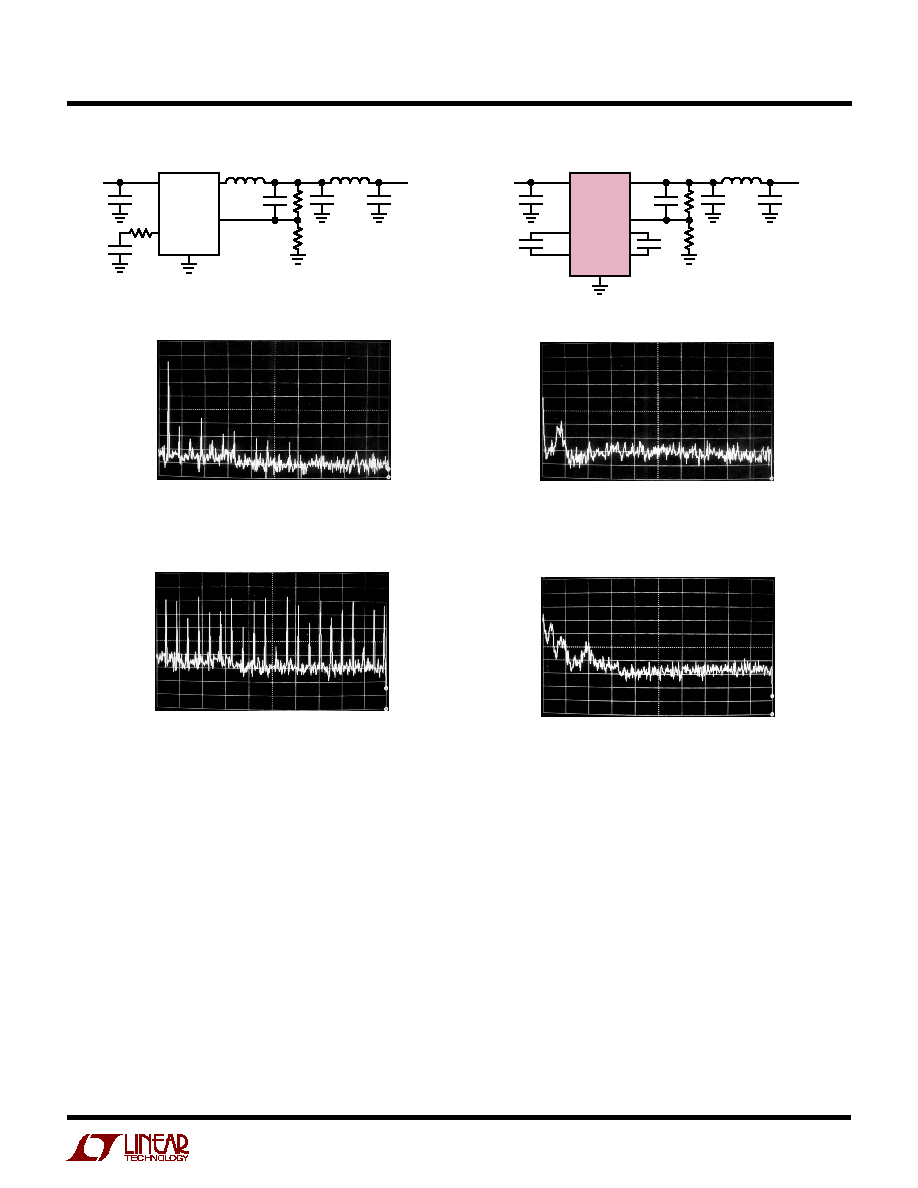
9
LTC3251/
LTC3251-1.2/LTC3251-1.5
32511215fa
Figure 1a. Conventional Buck Switching Converter
Figure 1b. Conventional Buck Converter Output Noise
Spectrum with 22
µ
F Output Capacitor (I
O
= 500mA)
Figure 1c. Conventional Buck Converter Input Noise
Spectrum with 10
µ
F Input Capacitor (I
O
= 500mA)
Figure 2a. LTC3251 Buck Converter
Figure 2b. LTC3251 Output Noise Spectrum
with 10
µ
F Output Capacitor (I
O
= 500mA)
Figure 2c. LTC3251 Input Noise Spectrum
with 1
µ
F Input Capacitor (I
O
= 500mA)
OPERATIO
U
(Refer to Block Diagram)
Unlike conventional buck converters, the LTC3251's inter-
nal oscillator is designed to produce a clock pulse whose
period is random on a cycle-by-cycle basis, but fixed
between 1MHz and 1.6MHz. This has the benefit of spread-
ing the switching noise over a range of frequencies, thus
significantly reducing the peak noise. Figures 2b and 2c
are the input and output noise spectrums for the LTC3251
of Figure 2a with V
IN
= 3.6V, V
OUT
= 1.5V and I
OUT
=
500mA. Note the significant reduction in peak output
noise (>20dBm) with only 1/2 the output capacitance and
the virtual elimination of input harmonics with only 1/10
the input capacitance. Spread spectrum operation is used
exclusively in "continuous" mode and for output currents
greater than about 50mA in Burst Mode operation.
Low Current Burst Mode Operation
To improve efficiency at low output currents, a Burst Mode
function is included in the LTC3251 family of parts. An
output current sense is used to detect when the required
output current drops below an internally set threshold
(50mA typ). When this occurs, the part shuts down the
internal oscillator and goes into a low current operating
state. The part will remain in the low current operating
state until the output voltage has dropped enough to
require another burst of current. When the output current
exceeds 50mA, the part will operate in continuous mode.
Unlike traditional charge pumps, where the burst current
is dependant on many factors (i.e., supply, switch strength,
SW
IN
COMP
22
µ
F
3251 F01a
V
OUT
4.7
µ
H
FB
V
IN
GND
10
µ
F
1
µ
F
10nH*
*10nH = 1cm OF PCB TRACE
OUT
IN
C1
+
C1
C2
+
C2
10
µ
F
3251 F02a
V
OUT
LTC3251
FB
V
IN
GND
1
µ
F
1
µ
F
1
µ
F
1
µ
F
10nH*
*10nH = 1cm OF PCB TRACE
40
50
NOISE (dBm)
60
70
80
90
START FREQ: 100kHz RBW: 10kHz STOP FREQ: 30MHz
3251 F01b
START FREQ: 100kHz RBW: 10kHz STOP FREQ: 30MHz
NOISE (dBm)
40
50
60
70
80
90
3251 F02b
NOISE (dBm)
START FREQ: 100kHz RBW: 10kHz STOP FREQ: 30MHz
40
50
60
70
80
90
3251 F01c
START FREQ: 100kHz RBW: 10kHz STOP FREQ: 30MHz
NOISE (dBm)
40
50
60
70
80
90
3251 F02c
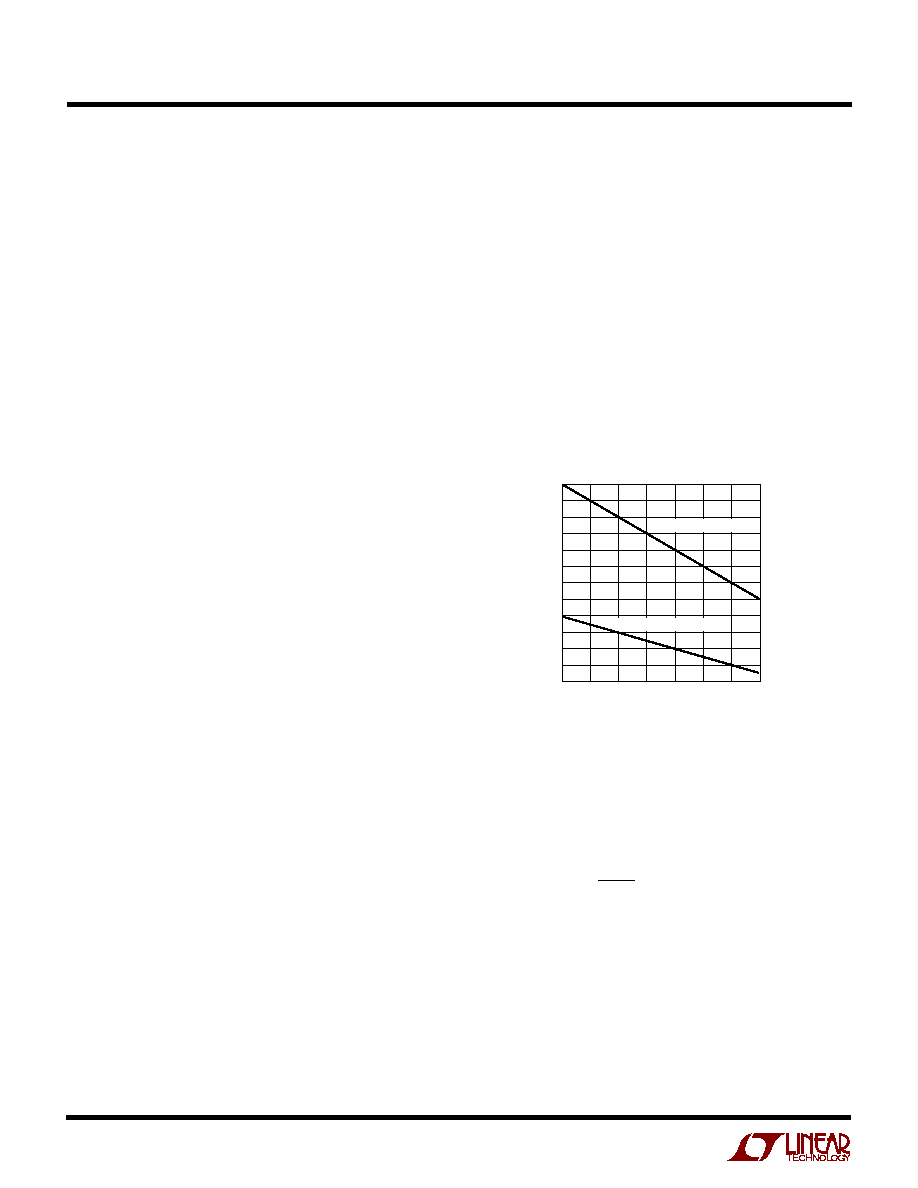
10
LTC3251/
LTC3251-1.2/LTC3251-1.5
32511215fa
OPERATIO
U
(Refer to Block Diagram)
Figure 3
capacitor selection, etc.), the part's burst current is set by
the burst threshold and hysteresis. This means that the
V
OUT
ripple voltage in Burst Mode operation will be fixed
and is typically 15mV with a 10
µ
F output capacitor.
Ultralow Current Super Burst Mode Operation
To further optimize the supply current for low output
current requirements, a Super Burst mode operaton is
included in the LTC3251 family of parts. This mode is very
similar to Burst Mode operation, but much of the internal
circuitry and switch is shut down to further reduce supply
current. In Super Burst mode operation an internal hyster-
etic comparator is used to enable/disable charge transfer.
The hysteresis of the comparator and the amount of
current deliverable to the output are limited to keep output
ripple low. The V
OUT
ripple voltage in Super Burst mode
operation is typically 35mV with a 10
µ
F output capacitor.
The LTC3251 family can deliver 40mA of current in Super
Burst mode operation but does not switch to continuous
mode. The MODE pin of the LTC3251-1.2 and LTC3251-
1.5 has no effect on operation in super-burst mode.
V
OUT
Capacitor Selection
The style and value of capacitors used with the LTC3251
family determine several important parameters such as
regulator control loop stability, output ripple and charge
pump strength.
The dual phase nature of the LTC3251 family minimizes
output noise significantly but not completely. What small
ripple that does exist is controlled by the value of C
OUT
directly. Increasing the size of C
OUT
will proportionately
reduce the output ripple. The ESR (equivalent series
resistance) of C
OUT
plays the dominant role in output
noise. When a part switches between clock phases there
is a period where all switches are turned off. This "blanking
period" shows up as a spike at the output and is a direct
function of the output current times the ESR value. To
reduce output noise and ripple, it is suggested that a low
ESR (<0.08
) ceramic capacitor be used for C
OUT
. Tanta-
lum and aluminum capacitors are not recommended be-
cause of their high ESR.
Both the style and value of C
OUT
can significantly affect the
stability of the LTC3251 family. As shown in the Block
Diagram, the LTC3251 family uses a control loop to adjust
the strength of the charge pump to match the current
required at the output. The error signal of this loop is
stored directly on the output charge storage capacitor.
Thus the charge storage capacitor also serves to form the
dominant pole for the control loop. The desired output
voltage also affects stability. As the divider ratio (R
A
/R
B
)
drops, the effective closed-loop gain increases, thus re-
quiring a larger output capacitor for stability. Figure 3
shows the suggested output capacitor for optimal tran-
sient response. The value of the output capacitance should
not drop below the minimum capacitance line to prevent
excessive ringing or instability. (see Ceramic Capacitor
Selection Guidelines section).
Likewise excessive ESR on the output capacitor will tend
to degrade the loop stability. The closed loop output
impedance of the LTC3251 is approximately:
R
V
V
O
OUT
=
0 045
0 8
.
·
.
For example, with the output programmed to 1.5V, the R
O
is 0.085
, which produces a 40mV output change for a
500mA load current step. For stability and good load
transient response, it is important for the output capacitor
to have 0.08
or less of ESR. Ceramic capacitors typically
have exceptional ESR, and combined with a tight board
layout, should yield excellent stability and load transient
performance.
V
OUT
(V)
0.9
C
OUT
(
µ
F)
8
14
15
16
1.1
1.3
1.4
3251 F03
6
12
10
7
13
4
5
11
9
1.0
1.2
1.5
1.6
OPTIMUM CAPACITANCE
MINIMUM CAPACITANCE

11
LTC3251/
LTC3251-1.2/LTC3251-1.5
32511215fa
Figure 5. 10nH Inductor Used for
Additional Input Noise Reduction
OPERATIO
U
(Refer to Block Diagram)
Figure 4. 10nH Inductor Used for
Additional Output Noise Reduction
V
OUT
10nH
(TRACE INDUCTANCE)
1
µ
F
10
µ
F
3251 F04
V
OUT
LTC3251
GND
V
IN
10nH
(TRACE INDUCTANCE)
1
µ
F
3251 F05
V
IN
SUPPLY
LTC3251
GND
Further output noise reduction can be achieved by filtering
the LTC3251 output through a very small series inductor
as shown in Figure 4. A 10nH inductor will reject the fast
output transients caused by the blanking period. The 10nH
inductor can be fabricated on the PC board with about 1cm
(0.4") of 1mm wide PC board trace.
Flying Capacitor Selection
Warning: A polarized capacitor such as tantalum or alumi-
num should never be used for the flying capacitors since
their voltages can reverse upon start-up of the LTC3251.
Ceramic capacitors should always be used for the flying
capacitors.
The flying capacitors control the strength of the charge
pump. In order to achieve the rated output current, it is
necessary for the flying capacitor to have at least 0.4
µ
F of
capacitance over operating temperature with a 2V bias
(see Ceramic Capacitor Selection Guidelines). If only
200mA or less of output current is required for the
application, the flying capacitor minimum can be reduced
to 0.15
µ
F.
Ceramic Capacitor Selection Guidelines
Capacitors of different materials lose their capacitance
with higher temperature and voltage at different rates. For
example, a ceramic capacitor made of X5R or X7R material
will retain most of its capacitance from 40
°
C to 85
°
C,
whereas a Z5U or Y5V style capacitor will lose consider-
able capacitance over that range (60% to 80% loss typ).
Z5U and Y5V capacitors may also have a very strong
voltage coefficient, causing them to lose an additional
60% or more of their capacitance when the rated voltage
is applied. Therefore, when comparing different capaci-
tors, it is often more appropriate to compare the amount
of achievable capacitance for a given case size rather than
discussing the specified capacitance value. For example,
over rated voltage and temperature conditions, a 4.7
µ
F,
10V, Y5V ceramic capacitor in an 0805 case may not
provide any more capacitance than a 1
µ
F, 10V, X5R or X7R
available in the same 0805 case. In fact, over bias and
V
IN
Capacitor Selection
The dual phase architecture used by the LTC3251 family
makes input noise filtering much less demanding than
conventional charge pump regulators. The input current
should be continuous at about I
OUT
/2. The blanking period
described in the V
OUT
section also effects the input. For
this reason it is recommended that a low ESR, 1
µ
F (0.4
µ
F
min) or greater ceramic capacitor be used for C
IN
(see
Ceramic Capacitor Selection Guidelines section).
In cases where the supply impedance is high, heavy output
transients can cause significant input transients. These
input transients feed back to the output which slows the
output transient recovery and increases overshoot and
output impedance. This effect can generally be avoided by
using low impedance supplies and short supply connec-
tions. If this is not possible, a
4.7
µ
F capacitor is recom-
mended for the input capacitor. Aluminum and tantalum
capacitors are not recommended because of their high
ESR.
Further input noise reduction can be achieved by filtering
the input through a very small series inductor as shown in
Figure 5. A 10nH inductor will reject the fast input tran-
sients caused by the blanking period, thereby presenting
a nearly constant load to the input supply. For economy,
the 10nH inductor can be fabricated on the PC board with
about 1cm (0.4") of 1mm wide PC board trace.

12
LTC3251/
LTC3251-1.2/LTC3251-1.5
32511215fa
OPERATIO
U
(Refer to Block Diagram)
Figure 6. Recommended Layout
temperature range, the 1
µ
F, 10V, X5R or X7R will provide
more capacitance than the 4.7
µ
F, 10V, Y5V. The capacitor
manufacturer's data sheet should be consulted to deter-
mine what value of capacitor is needed to ensure mini-
mum capacitance values are met over operating tempera-
ture and bias voltage.
Below is a list of ceramic capacitor manufacturers and
how to contact them:
AVX
www.avxcorp.com
Kemet
www.kemet.com
Murata
www.murata.com
Taiyo Yuden
www.t-yuden.com
TDK
www.tdk.com
Layout Considerations
Due to the high switching frequency and transient currents
produced by the LTC3251, careful board layout is neces-
sary for optimal performance. A true ground plane and
short connections to all capacitors will improve perfor-
mance and ensure proper regulation under all conditions.
Figure 6 shows the recommended layout configuration.
GND
V
IN
V
OUT
3251 F06
C2
1
µ
F
C
O
10
µ
F
R
B
R
A
C1
1
µ
F
C
I
1
µ
F
C
A
5pF
LTC3251 COMPONENTS NOT USED ON
THE LTC3251-1.2 OR LTC3251-1.5
The flying capacitor pins C1
+
, C1
, C2
+
, C2
will have very
high edge rate wave forms. The large dv/dt on these pins
can couple energy capacitively to adjacent printed circuit
board runs. Magnetic fields can also be generated if the
flying capacitors are not close to the part (i.e., the loop area
is large). To decouple capacitive energy transfer, a Faraday
shield may be used. This is a grounded PC trace between
the sensitive node and the IC's pins. For a high quality AC
ground, it should be returned to a solid ground plane that
extends all the way to the part. Keep the FB trace of the
LTC3251 away from or shielded from the flying capacitor
traces or degraded performance could result.
Thermal Management
If the junction temperature increases above approximately
160
°
C, the thermal shutdown circuitry will automatically
deactivate the output. To reduce the maximum junction
temperature, a good thermal connection to the PC board
is recommended. Connecting the 10-pin MSE paddle
directly to a ground plane, and maintaining a solid ground
plane under the device on one or more layers of the PC
board, can reduce the thermal resistance of the package
and PC board considerably. Using this method a
JA
of
40
°
C/W should be achieved.
Power Efficiency
The power efficiency (
) of the LTC3251 family is approxi-
mately double that of a conventional linear regulator. This
occurs because the input current for a 2-to-1 step-down
charge pump is approximately half the output current. For
an ideal 2-to-1 step-down charge pump the power effi-
ciency is given by:
=
=
P
P
V
I
V
I
V
V
OUT
IN
OUT
OUT
IN
OUT
OUT
IN
·
·
1
2
2

13
LTC3251/
LTC3251-1.2/LTC3251-1.5
32511215fa
OPERATIO
U
(Refer to Block Diagram)
Figure 7. Programming the LTC3251
V
OUT
C
OUT
C
A
R
A
R
B
3251 F07
V
OUT
LTC3251
FB
GND
0.8V
R
A
R
B
1 +
( )
At moderate to high output power the switching losses
and quiescent current of the LTC3251 family is negligible
and the expression above is valid. For example with V
IN
=
3.6V, I
OUT
= 200mA and V
OUT
regulating to 1.5V the
measured efficiency is 81% which is in close agreement
with the theoretical 83.3% calculation.
Programming the LTC3251 Output Voltage (FB Pin)
The LTC3251 is programmed to an arbitrary output volt-
age via an external resistive divider. Figure 7 shows the
required voltage divider connection. The voltage divider
ratio is given by the expression:
PD
V
V
I
IN
OUT
OUT
=
2
For a 1.5V output, R
O
is 0.085
, which produces a 40mV
output change for a 500mA load current step. Thus, the
user may want to target an unloaded output voltage
slightly higher than desired to compensate for the output
load conditions. The output may be programmed for
regulation voltages of 0.9V to 1.6V.
Since the LTC3251 employs a 2-to-1 charge pump archi-
tecture, it is not possible to achieve output voltages
greater than half the available input voltage. The minimum
V
IN
supply required for regulation can be determined by
the following equation:
V
IN(MIN)
2 · (V
OUT(MIN)
+ I
OUT
· R
OL
)
The compensation capacitor (C
A
) is necessary to counter-
act the pole caused by the large valued resistors R
A
and R
B
,
and the input capacitance of the FB pin. For best results, C
A
should be 5pF for all R
A
or R
B
greater than 10k and can be
omitted if both R
A
and R
B
are less than 10k.
Disabling Spread Spectrum Operation on the
LTC3251-1.2/LTC3251-1.5 (MODE Pin)
Spread spectrum operation can be disabled by driving
MODE high. When Mode is high, switching takes place at
the maximum operating frequency (typ 1.6MHz). The
advantage of spread spectrum operation is that it reduces
the peak noise at and above the operating frequency at the
expense of a slightly increased noise floor and slightly
increased low frequency ripple caused by the converter
compensating for the changing operating frequency. Us-
ers who do not need the peak noise reduction gained by
using spread spectrum may wish to disable spread spec-
trum, thus improving the low frequency input/output
ripple.
Typical values for total voltage divider resistance can range
from several k
s up to 1M
.
The user may want to consider load regulation when setting
the desired output voltage. The closed loop output imped-
ance of the LTC3251 is approximately:
R
R
V
V
A
B
OUT
=
0 8
1
.
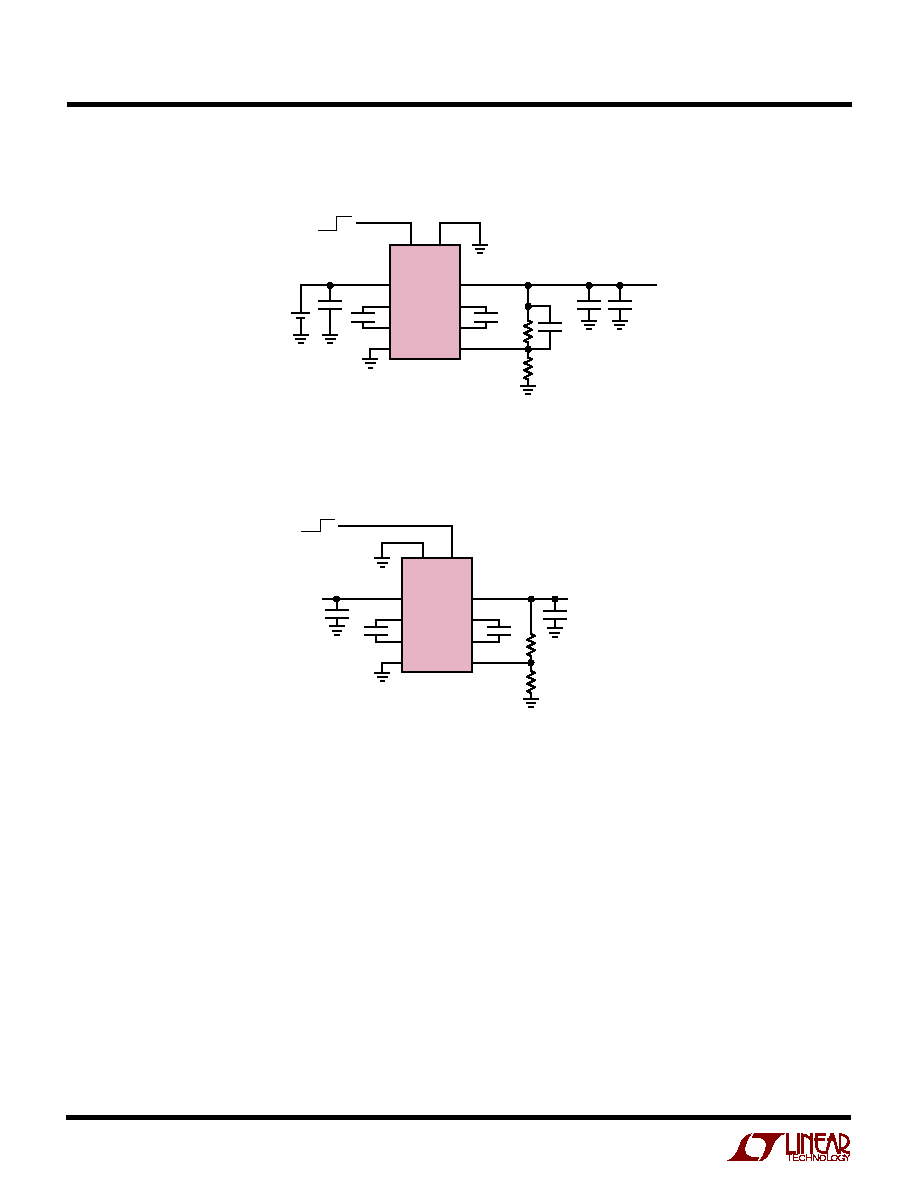
14
LTC3251/
LTC3251-1.2/LTC3251-1.5
32511215fa
TYPICAL APPLICATIO S
U
MD0 MD1
LTC3251
V
IN
1
9
C1
+
1
µ
F
1
µ
F
C1
GND
7
8
6
10
2
OFF ON
V
IN
3.3V
3
4
5,11
V
OUT
C2
+
C2
FB
1
µ
F
10
µ
F
V
OUT
= 1.4V
I
OUT
350mA
4.12k
5.36k
3251 TA03
MD0 MD1
LTC3251
V
IN
1
9
C1
+
1
µ
F
1
µ
F
1-CELL
Li-Ion
OR
3-CELL
NiMH
OFF ON
C1
GND
7
8
6
10
2
3
4
5,11
V
OUT
C2
+
C2
FB
1
µ
F
10
µ
F
V
OUT
= 0.9V
500mA
73.2k
5pF
536k
3251 TA05
4.7
µ
F
0.9V Output Continuous/Burst Mode Operation with Shutdown
3.3V to 1.4V Conversion, Continuous
Spread Spectrum Operation with Shutdown
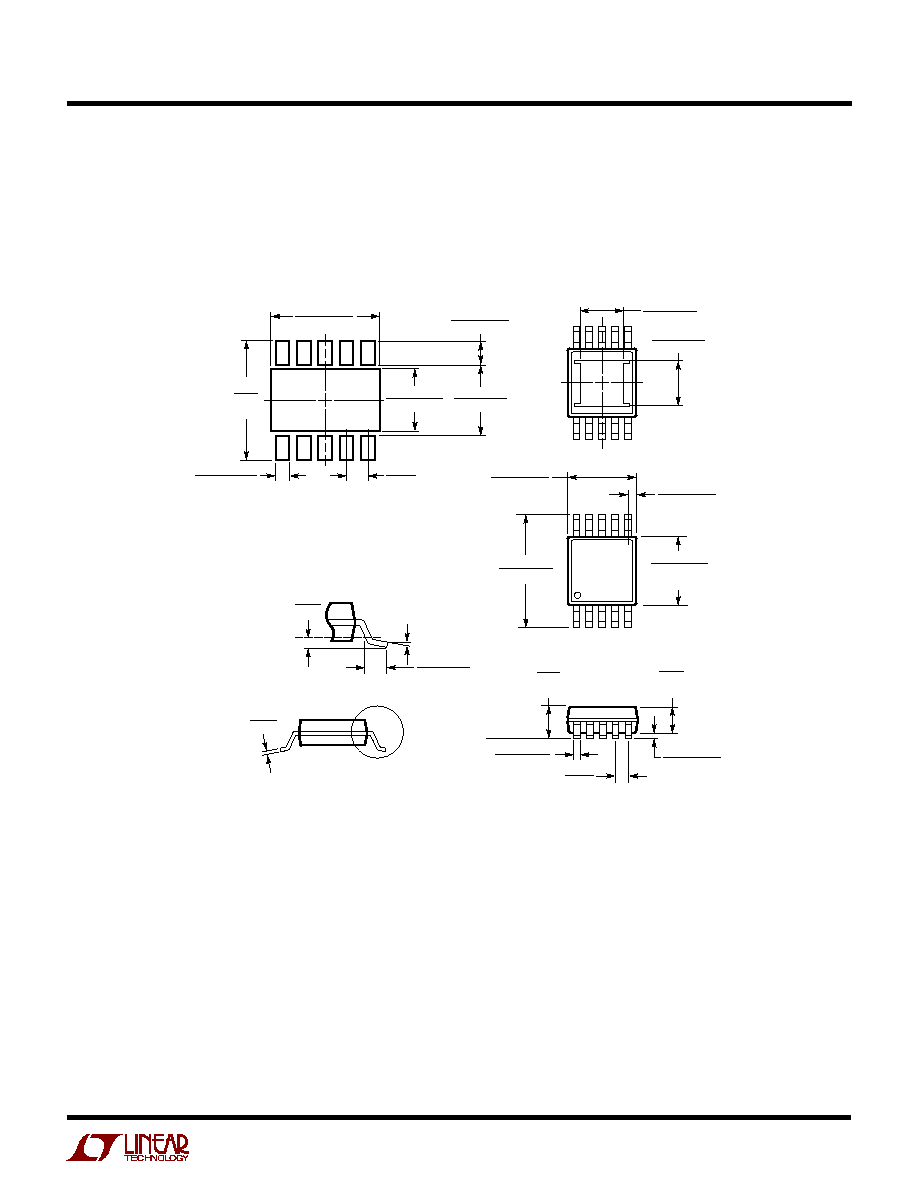
15
LTC3251/
LTC3251-1.2/LTC3251-1.5
32511215fa
Information furnished by Linear Technology Corporation is believed to be accurate and reliable.
However, no responsibility is assumed for its use. Linear Technology Corporation makes no represen-
tation that the interconnection of its circuits as described herein will not infringe on existing patent rights.
U
PACKAGE DESCRIPTIO
MSE Package
10-Lead Plastic MSOP
(Reference LTC DWG # 05-08-1663)
MSOP (MSE) 0603
0.53
±
0.152
(.021
±
.006)
SEATING
PLANE
0.18
(.007)
1.10
(.043)
MAX
0.17 0.27
(.007 .011)
TYP
0.127
±
0.076
(.005
±
.003)
0.86
(.034)
REF
0.50
(.0197)
BSC
1 2 3 4 5
4.90
±
0.152
(.193
±
.006)
0.497
±
0.076
(.0196
±
.003)
REF
8
9
10
10
1
7 6
3.00
±
0.102
(.118
±
.004)
(NOTE 3)
3.00
±
0.102
(.118
±
.004)
(NOTE 4)
NOTE:
1. DIMENSIONS IN MILLIMETER/(INCH)
2. DRAWING NOT TO SCALE
3. DIMENSION DOES NOT INCLUDE MOLD FLASH, PROTRUSIONS OR GATE BURRS.
MOLD FLASH, PROTRUSIONS OR GATE BURRS SHALL NOT EXCEED 0.152mm (.006") PER SIDE
4. DIMENSION DOES NOT INCLUDE INTERLEAD FLASH OR PROTRUSIONS.
INTERLEAD FLASH OR PROTRUSIONS SHALL NOT EXCEED 0.152mm (.006") PER SIDE
5. LEAD COPLANARITY (BOTTOM OF LEADS AFTER FORMING) SHALL BE 0.102mm (.004") MAX
0.254
(.010)
0
°
6
°
TYP
DETAIL "A"
DETAIL "A"
GAUGE PLANE
5.23
(.206)
MIN
3.20 3.45
(.126 .136)
0.889
±
0.127
(.035
±
.005)
RECOMMENDED SOLDER PAD LAYOUT
0.305
±
0.038
(.0120
±
.0015)
TYP
2.083
±
0.102
(.082
±
.004)
2.794
±
0.102
(.110
±
.004)
0.50
(.0197)
BSC
BOTTOM VIEW OF
EXPOSED PAD OPTION
1.83
±
0.102
(.072
±
.004)
2.06
±
0.102
(.081
±
.004)
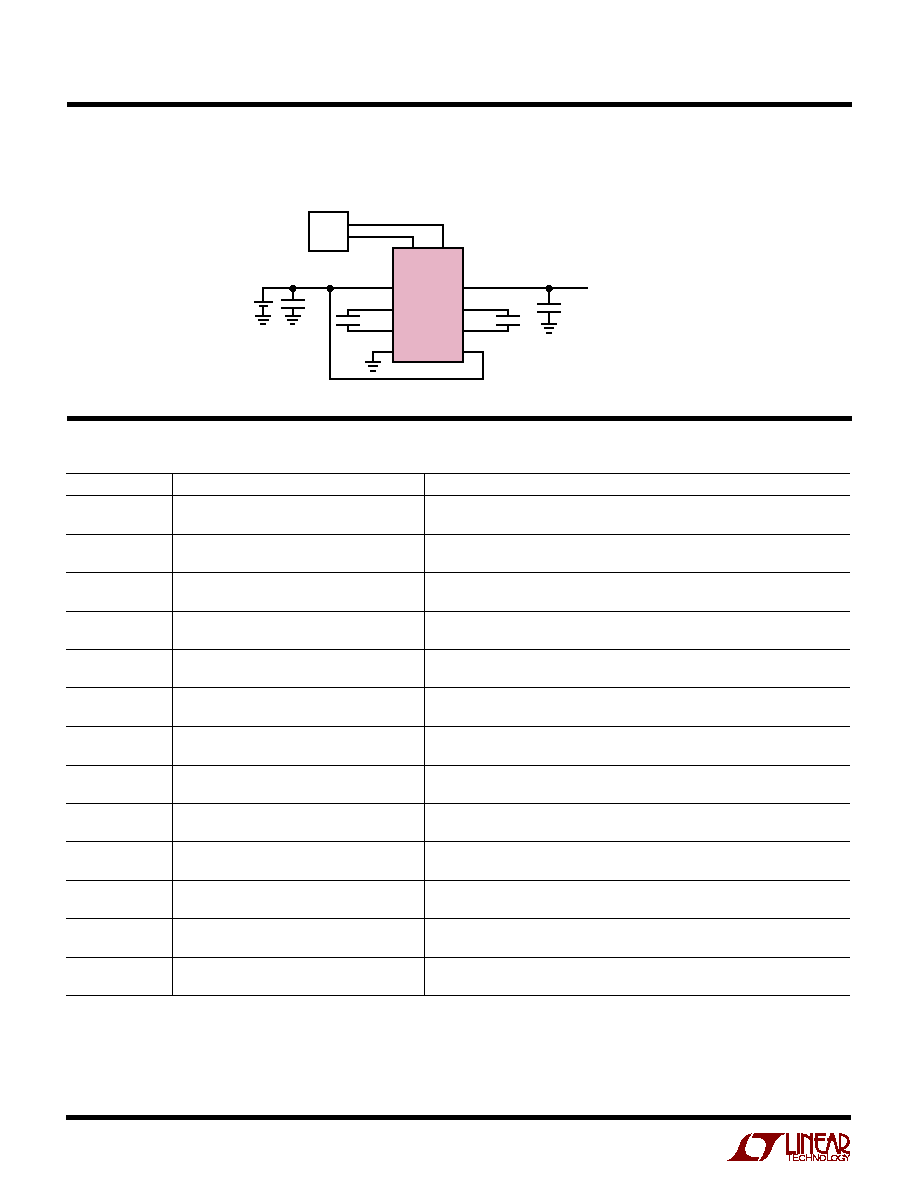
16
LTC3251/
LTC3251-1.2/LTC3251-1.5
32511215fa
PART NUMBER
DESCRIPTION
COMMENTS
LTC1514
50mA, 650kHz, Step-Up/Down Charge Pump
V
IN
: 2.7V to 10V, V
OUT
: 3V or 5V, Regulated Output, I
Q
: 60
µ
A,
with Low Battery Comparator
I
SD
: 10
µ
A, S8 Package
LTC1515
50mA, 650kHz, Step-Up/Down Charge Pump
V
IN
: 2.7V to 10V, V
OUT
: 3.3V or 5V, Regulated Output, I
Q
: 60
µ
A,
with Power-On Reset
I
SD
: <1
µ
A, S8 Package
LT1776
500mA (I
OUT
), 200kHz, High Efficiency
90% Efficiency, V
IN
: 7.4V to 40V, V
OUT(MIN)
: 1.24V,
Step-Down DC/DC Converter
I
Q
: 3.2mA, I
SD
: 30
µ
A, N8, S8 Packages
LTC1911-1.5/
250mA, 1.5MHz, High Efficiency
Up to 90% Efficiency, V
IN
: 2.7V to 5.5V, V
OUT
: 1.5V/1.8V, Regulated Output,
LTC1911-1.8
Step-Down Charge Pump
I
Q
: 180
µ
A, I
SD
: 10
µ
A, MS8 Package
LTC3250-1.5
250mA, 1.5MHz, High Efficiency
Up to 90% Efficiency, V
IN
: 3.1V to 5.5V, V
OUT
: 1.5V, Regulated Output,
Step-Down Charge Pump
I
Q
: 35
µ
A, I
SD
: <1
µ
A, ThinSOT Package
LTC3252
250mA, Dual, Low Noise, Inductorless
Up to 90% Efficiency, V
IN
: 2.7V to 5.5V, V
OUT
: 0.9V to 1.6V,
Step-Down DC/DC Converter
I
Q
: 60
µ
A, DFN Package
LTC3404
600mA (I
OUT
), 1.4MHz, Synchronous
95% Efficiency, V
IN
: 2.7V to 6V, V
OUT(MIN)
: 0.8V,
Step-Down DC/DC Converter
I
Q
: 10
µ
A, I
SD
: <1
µ
A, MS8 Package
LTC3405/LTC3405A 300mA (I
OUT
), 1.5MHz, Synchronous
95% Efficiency, V
IN
: 2.7V to 6V, V
OUT(MIN)
: 0.8V,
Step-Down DC/DC Converter
I
Q
: 20
µ
A, I
SD
: <1
µ
A, ThinSOT Package
LTC3406/LTC3406B 600mA (I
OUT
), 1.5MHz, Synchronous
95% Efficiency, V
IN
: 2.5V to 5.5V, V
OUT(MIN)
: 0.6V,
Step-Down DC/DC Converter
I
Q
: 20
µ
A, I
SD
: <1
µ
A, ThinSOT Package
LTC3411
1.25A (I
OUT
), 4MHz, Synchronous Step-Down
95% Efficiency, V
IN
: 2.5V to 5.5V, V
OUT(MIN)
: 0.8V,
DC/DC Converter
I
Q
: 60
µ
A, I
SD
: <1
µ
A, MS Package
LTC3412
2.5A (I
OUT
), 4MHz, Synchronous Step-Down
95% Efficiency, V
IN
: 2.5V to 5.5V, V
OUT(MIN)
: 0.8V,
DC/DC Converter
I
Q
: 60
µ
A, I
SD
: <1
µ
A, TSSOP-16E Package
LTC3440
600mA (I
OUT
), 2MHz, Synchronous
95% Efficiency, V
IN
: 2.5V to 5.5V, V
OUT
: 2.5V to 5.5V,
Buck-Boost DC/DC Converter
I
Q
: <25
µ
A, I
SD
: 1
µ
A, MS Package
LTC3441
1.2A (I
OUT
), 1MHz, Synchronous
95% Efficiency, V
IN
: 2.4V to 5.5V, V
OUT
: 2.4V to 5.25V,
Buck-Boost DC/DC Converter
I
Q
: <25
µ
A, I
SD
: 1
µ
A, DFN Package
LT/TP 1203 1K · PRINTED IN USA
©
LINEAR TECHNOLOGY CORPORATION 2003
RELATED PARTS
Linear Technology Corporation
1630 McCarthy Blvd., Milpitas, CA 95035-7417
(408) 432-1900
q
FAX: (408) 434-0507
q
www.linear.com
U
TYPICAL APPLICATIO
MD0 MD1
LTC3251-1.2
V
IN
1
9
C1
+
1
µ
F
1
µ
F
1-CELL Li-Ion
OR
3-CELL NiMH
C1
GND
7
8
6
10
2
3
4
5,11
V
OUT
C2
+
C2
MODE
1
µ
F
10
µ
F
X5R
6.3V
V
OUT
= 1.2V
I
OUT
UP TO 300mA, V
IN
2.8V
I
OUT
UP TO 500mA, V
IN
3.0V
3251 TA04
µ
P
1.2V Output with mProcessor Control of Operating Modes (Spread Spectrum Disabled)















